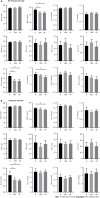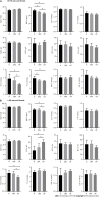Relationships among body weight, lipids and bone mass in elderly individuals with fractures: A case-control study
- PMID: 37744715
- PMCID: PMC10514712
- DOI: 10.5312/wjo.v14.i9.720
Relationships among body weight, lipids and bone mass in elderly individuals with fractures: A case-control study
Abstract
Background: The prevalence of osteoporosis and low bone mass is steadily rising each year. Low body weight is commonly linked to diminished bone mass and serves as a robust predictor of osteoporosis. Nonetheless, the connection between body mass index (BMI), bone mineral density, and lipid profiles among the elderly remains elusive.
Aim: To examine the association between BMI and bone mass, explore the correlation between lipid profiles and bone mass, and delve into the interplay between lipid metabolism and bone health.
Methods: The study included 520 patients aged ≥ 65 years (178 men and 342 women). Age, sex, weight, and height were recorded. Femoral neck bone mineral density and T scores were determined using a dual-energy X-ray absorptiometry scanner. Blood calcium (Ca), phosphorus (P), albumin (ALB), alkaline phosphatase (ALP), aspartate aminotransferase, alanine aminotransferase, triglyceride (TG), total cholesterol (TC), high-density lipoprotein (HDL) and low-density lipoprotein (LDL) levels were measured. Patients were classified by sex (male and female), age (65-79 years and ≥ 80 years), and T score (normal bone mineral density, osteopenia and osteoporosis).
Results: Age, sex, BMI, and ALP and TG levels were independent risk factors for osteoporosis. For the 65-79- and ≥ 80-year-old groups, females presented lower T scores than males. Ca, P, ALB, ALP, TC, HDL and LDL levels were significantly different between men and women in the 65-79-year-old group. In addition, BMI and TG levels were significantly decreased in osteoporotic patients compared with patients with normal bone mass. TC levels declined in 65- to 79-year-old male and female osteoporosis patients. In the group of women aged ≥ 80 years, osteoporotic patients showed significantly increased ALP levels. Furthermore, we found positive correlations between BMI and TG levels in the male and female patient groups. However, we found no significant differences in ALB, Ca, P, HDL and LDL levels in osteoporotic patients compared to patients with normal bone mass.
Conclusion: Osteoporotic patients showed significantly decreased BMI and TG levels compared with those with normal bone mass. BMI showed positive correlations with TG levels in male and female patients. These results indicate correlations between BMI and bone mass and between lipid profiles and bone mass.
Keywords: Body mass index; Elderly patients; Lipid profiles; Osteoporosis; Weight loss.
©The Author(s) 2023. Published by Baishideng Publishing Group Inc. All rights reserved.
Conflict of interest statement
Conflict-of-interest statement: The authors declare no competing financial interests or conflicts of interest that could have influenced the design, data collection, analysis, interpretation, or publication of this study.
Figures



Similar articles
-
Correlation between bone density, bone metabolism markers with lipid metabolism markers and body mass index.BMC Musculoskelet Disord. 2024 Feb 20;25(1):162. doi: 10.1186/s12891-024-07284-6. BMC Musculoskelet Disord. 2024. PMID: 38378530 Free PMC article.
-
Associations between the lipid profile and the lumbar spine bone mineral density and trabecular bone score in elderly Iranian individuals participating in the Bushehr Elderly Health Program: a population-based study.Arch Osteoporos. 2019 May 11;14(1):52. doi: 10.1007/s11657-019-0602-5. Arch Osteoporos. 2019. PMID: 31079228
-
Assessment risk of osteoporosis in Chinese people: relationship among body mass index, serum lipid profiles, blood glucose, and bone mineral density.Clin Interv Aging. 2016 Jul 4;11:887-95. doi: 10.2147/CIA.S103845. eCollection 2016. Clin Interv Aging. 2016. PMID: 27445467 Free PMC article.
-
A comparative research on obesity hypertension by the comparisons and associations between waist circumference, body mass index with systolic and diastolic blood pressure, and the clinical laboratory data between four special Chinese adult groups.Clin Exp Hypertens. 2018;40(1):16-21. doi: 10.1080/10641963.2017.1281940. Epub 2017 Oct 30. Clin Exp Hypertens. 2018. PMID: 29083240
-
Bone mineral density and its correlation with clinical and laboratory factors in chronic peritoneal dialysis patients.J Bone Miner Metab. 2006;24(1):79-86. doi: 10.1007/s00774-005-0650-3. J Bone Miner Metab. 2006. PMID: 16369903
Cited by
-
Lumbar localized fat distribution parameters are independent predictors of osteoporotic vertebral compression re-fractures (OVCRFs) following Percutaneous Kyphoplasty (PKP): a retrospective matched case-control study.Skeletal Radiol. 2025 May;54(5):1071-1080. doi: 10.1007/s00256-024-04815-z. Epub 2024 Oct 12. Skeletal Radiol. 2025. PMID: 39394355
-
Assessment of Personalized Exercise Prescriptions Issued by ChatGPT 4.0 and Intelligent Health Promotion Systems for Patients with Hypertension Comorbidities Based on the Transtheoretical Model: A Comparative Analysis.J Multidiscip Healthc. 2024 Nov 9;17:5063-5078. doi: 10.2147/JMDH.S477452. eCollection 2024. J Multidiscip Healthc. 2024. PMID: 39539514 Free PMC article.
-
CT-Based Evaluation of Bone Mineral Density Distribution of Proximal Femur in Patients With Femoral Trochanteric Fracture.Geriatr Orthop Surg Rehabil. 2025 Jul 18;16:21514593251361803. doi: 10.1177/21514593251361803. eCollection 2025. Geriatr Orthop Surg Rehabil. 2025. PMID: 40688361 Free PMC article.
References
-
- Nayak S, Olkin I, Liu H, Grabe M, Gould MK, Allen IE, Owens DK, Bravata DM. Meta-analysis: accuracy of quantitative ultrasound for identifying patients with osteoporosis. Ann Intern Med. 2006;144:832–841. - PubMed
LinkOut - more resources
Full Text Sources
Miscellaneous

